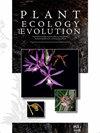栀子科龙胆属新热带植物的系统学研究(栀子科龙胆属)
IF 1.1
4区 生物学
Q3 PLANT SCIENCES
引用次数: 3
摘要
背景和目的——热带部落栀子科(Ixoroideae,茜草科)的属界部分尚未确定。我们对Randia分支进行了新的系统发育,重点介绍了其新热带分支,包括五个属(Casasia、Randia、Rosenbergiodendron、Sphintanthus和Tocoyena)。该结果随后用于评估和讨论:a)上述属各自的单系性及其相互关系;b) Tocoyena内部的关系及其亚属分类的进化相关性;和c)形态可变的台湾T.formosa的单系性。材料和方法——我们根据59个个体(包括其余Ixoroideae的7个代表)的两个细胞核(ETS和Xdh)和两个质体(petB-petD和trnT-F)DNA区域的序列数据的最大似然和贝叶斯分析,检查了Randia分支的系统发育。主要结果-Randia分支的新热带分支包括三个主要谱系,Randia armata亚支、Randia Casasia亚支和Rosenbergiodendron亚支。Casasia和Randia都不是单系的。Tocoyena是Rosenbergiodendron+Sphntanthus的姐妹,分为三个谱系:Tocoyena-pittieri群、Tocoyene-guianensis群和核心Tocoyene。Tocoyena williamsii是关于T.pittieri的转述。台湾Tocoyna formosa是多系的,应该重新界定。结论-我们的研究结果证明了Rosenbergiodendron、Sphntanthus和Tocoyena这三个物种相对贫乏的属的单系性,并证实了它们的密切亲缘关系。Tocoyena的系列分类并不能反映该属的进化史。T.williamsii相对于T.pittieri的并列性,以及它们的形态相似性和地理分布,支持将前者纳入后者。我们的研究呼吁对Casasia和物种更丰富的Randia属进行更多的系统发育研究。虽然这两个属各自的单系在这里被拒绝,但未来需要对Randia进行更广泛的研究。本文章由计算机程序翻译,如有差异,请以英文原文为准。
Phylogeny of the Neotropical element of the Randia clade (Gardenieae, Rubiaceae, Gentianales)
Background and aims – Generic limits of the tropical tribe Gardenieae (Ixoroideae, Rubiaceae) have partly remained unsettled. We produced a new phylogeny of the Randia clade, with emphasis on its Neotropical clade comprising five genera (Casasia, Randia, Rosenbergiodendron, Sphinctanthus, and Tocoyena). The result was subsequently used to evaluate and discuss: a) the respective monophyly of the above-mentioned genera and their interrelationships; b) relationships within Tocoyena and the evolutionary relevance of its subgeneric classification; and c) the monophyly of the morphologically variable T. formosa.Material and methods – We examined the phylogeny of the Randia clade based on maximum likelihood and Bayesian analyses of sequence data from two nuclear (ETS and Xdh) and two plastid (petB-petD and trnT-F) DNA regions from 59 individuals (including seven representatives from the remaining Ixoroideae).Key results – The Neotropical clade of the Randia clade comprises three major lineages, the Randia armata subclade, the Randia-Casasia subclade and the Rosenbergiodendron subclade. Neither Casasia nor Randia is monophyletic. Tocoyena is sister to Rosenbergiodendron + Sphinctanthus and is subdivided into three lineages: the Tocoyena pittieri group, the Tocoyena guianensis group, and the core Tocoyena. Tocoyena williamsii is paraphyletic with respect to T. pittieri. Tocoyena formosa is polyphyletic and should be re-circumscribed.Conclusions – Our results demonstrate the monophyly of each of the relatively species-poor genera Rosenbergiodendron, Sphinctanthus, and Tocoyena, and confirm their close affinity. The serial classification of Tocoyena does not reflect the evolutionary history of the genus. The paraphyly of T. williamsii with respect to T. pittieri, together with their morphological similarities and geographic distributions, support the inclusion of the former in the latter. Our study calls for additional phylogenetic work on Casasia and the more species-rich genus Randia. While the respective monophyly of both genera is rejected here, future work with a broader representation of Randia is needed.
求助全文
通过发布文献求助,成功后即可免费获取论文全文。
去求助
来源期刊

Plant Ecology and Evolution
PLANT SCIENCES-
CiteScore
2.20
自引率
9.10%
发文量
27
审稿时长
>12 weeks
期刊介绍:
Plant Ecology and Evolution is an international peer-reviewed journal devoted to ecology, phylogenetics and systematics of all ‘plant’ groups in the traditional sense (including algae, cyanobacteria, fungi, myxomycetes), also covering related fields.
The journal is published by Meise Botanic Garden and the Royal Botanical Society of Belgium.
 求助内容:
求助内容: 应助结果提醒方式:
应助结果提醒方式:


